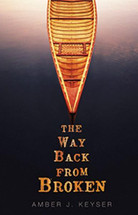The way back from broken by Amber J. Keyser

Carolrhoda Lab, 2018. ISBN 9781541514881
(Age: 14+) Recommended. Themes: Sibling death. Grief. Wilderness.
Survival. Rakmen's baby sister died and the family is working
through the tragedy in their own ways. He and his mother attend
weekly meetings at Promise House, a support group where the mothers
cry and the children do art therapy downstairs. His father won't go,
like others he goes to the bar and bottles up the grief. Rakmen
helps out with the other damaged kids, including some his age,
Molly, who survived a car crash that killed her sister, D'Veray and
D'Mareay, identical twins whose brother D'Shawn died of cancer.
Their shared experiences help them to understand each other, unlike
Rakmen's best friend Juan, who can't understand why he has lost
interest in sport, girls and the excitement of finishing school.
When his Biology teacher, Mrs Tatlas, turns up at the support group
consumed with grief over her stillborn son, Rakmen's mother
befriends her and he is thrust together with her young daughter
Jacey. His own parents are going through troubled times and so when
he is invited to spend the summer at a remote Canadian lake they ask
him to go, not only to look after Jacey and her mum but to give them
space to find a way forward. The lake is very remote and the
family's cabin run down but it is very beautiful and Mrs Tatlas,
Leah, decides on a canoe camping trip 'au large' in the wilderness.
The trip is very challenging but they gradually find a rhythm to
their days, paddling, carrying the canoe and setting up camp to
collapse exhausted at the end of the day, an escape from the
exhaustion of grief. When Leah breaks her ankle four days away from
anywhere Rakmen and Jacey have to go for help. Loaded with
responsibility Rakmen exceeds his own expectations and dramatically
opts for survival and the living, moving on from blaming himself for
his sister's loss.
This sensitive exploration of grief and healing acknowledges the
complexity of the issue; the triggers, the depression and volatile
behaviour, the self-blame, family breakdown and damage to
relationships caused by the death of a child. The finely drawn
description of the beautiful, scary and dangerous wilderness is a
real strength, powerfully asserting that life is larger than grief,
allowing the characters to discover resilience counteracting the
hopelessness at the start of the book. Recommended for students
looking for a serious read to engage the emotions or anyone dealing
with, or wishing to understand, aspects of grieving.
Sue Speck